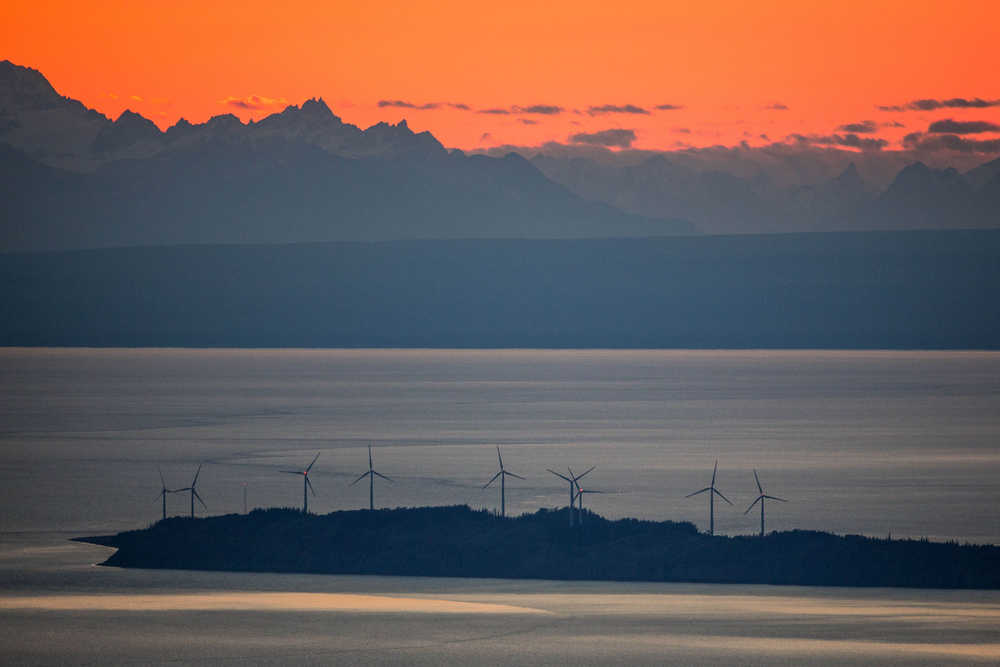ANCHORAGE, Alaska (AP) — Plans to add turbines to the Fire Island Wind project were suspended this month when the project ran into a hitch: No one wants to buy the power.
Suzanne Gibson, senior director of energy development for Cook Inlet Region Inc., said the independent power producer had to cancel construction and shipping contracts that would have added 11 wind turbines to Anchorage’s Fire Island. That happened after Alaska Railbelt utilities declined to purchase the company’s power following two years of negotiations.
Fire Island Wind, a subsidiary of CIRI, had hoped to begin construction on the turbines this spring and finish by the end of the year.
At a cost of $50 million, 11 new turbines would add just over 20 megawatts of capacity to the Railbelt region from Fairbanks to Seward, or enough to power roughly 7,000 additional homes, according to Gibson. That would be on top of the 17.6 megawatts the 11 turbines now on the island produce.
Gibson said Fire Island Wind was offering to sell power from Phase 2 of the project for 6.2 cents a kilowatt-hour, slightly higher than the cost of gas-fired power generation but less than the project’s 9.7-cent rate for Phase 1.
But utilities say that 6.2 cents comes with added costs as the power is moved throughout the transmission grid. Interior Alaska’s Golden Valley Electric Association said that by the time it received the power, it would be at about double the original cost and not economical.
“We really looked at it closely because if it would have lowered members’ rates we would have jumped on board,” said Mike Wright, GVEA vice president of transmission and distribution. “But it just came out too high because of the logistics.”
Energy prices in Fairbanks are some of the highest on the Railbelt at 20 cents a kilowatt-hour. In comparison, the cost to produce natural gas-powered energy in Southcentral Alaska is closer to 5 cents a kilowatt-hour.
“We support renewables, but do we support renewables that raise (the) cost to our members? No,” Wright said in an interview this week.
It’s not the first time Fire Island Wind has had difficulty securing a buyer for its wind-generated power. The first phase of the project was approved in 2011 after contentious Regulatory Commission of Alaska meetings in which the Alaska Department of Law and Anchorage’s Municipal Light and Power argued buying the power would cost ratepayers more over the long run. The project was scaled down from a possible 33 turbines on the 4,300-acre island to 11 when attempts to find additional power buyers failed. Chugach Electric Association eventually signed onto the project with a 25-year contract to buy power at 9.7 cents a kilowatt-hour. The project came online in September 2012.
CIRI has contended that despite the higher initial cost of wind power, the cost of gas power will likely increase in coming years, making wind-powered electricity more economical in the long run.
But wind is a variable resource. The variation requires additional generation at all times to maintain consistent power throughout the system. That fluctuation can sometimes mean additional costs for the utilities that have to generate more power when wind power dips. Chugach spokesman Phil Steyer said that when the utility signed onto the project in 2011 it concluded that the amount of power being provided was “about as big as we could handle” in terms of regulating it.
Julie Estey, spokeswoman for Matanuska Electric Association, said the utility “seriously considered” purchasing the Fire Island power. MEA’s Eklutna Generation Plant, scheduled to come online in coming months, consists of 10 smaller generators. Estey said that makes it easier for the utility to manage the variable wind power, since it takes less effort to regulate the shifting amount of power coming in.
But with that plant not online yet and operational costs uncertain, Estey said, it was difficult to justify entering into a long-term contract with Fire Island Wind.
“There’s a lot of wrinkles here and it basically added up to (the fact that) we couldn’t make this happen in an economic way for our members,” she said.
CIRI’s Gibson said the cost of power for Phase 2 is lower because existing infrastructure is driving down costs. The company completed some work at the end of 2013, starting construction on roads to the new turbine sites and digging foundations in order to take advantage of $15 million in tax credits from the American Recovery and Reinvestment Act.
Gibson said where the project goes from here depends on that tax credit, which stipulates when the new turbines must be completed but is in flux as the IRS reviews its timetable.
Both MEA and GVEA said they would be interested in the project in the coming years if it could be made more economical. Gibson said she understands the pressures utilities are facing, especially ML&P and MEA, which are finishing new power plants this year.
“We’re not giving up on the utilities,” she said. “I hope they will see more value in the project a year (from) now.”

